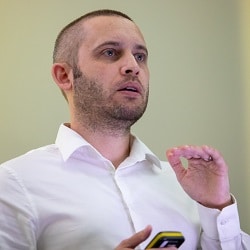Posted by Sam Borrett, director of Legal Futures Associate Legmark

Borrett: Content needs to be spot on
Having a website is like advertising on a billboard in the middle of the desert – it’s pretty useless unless people are driving past to see it.
Imagine the global cyberspace as a desert, an empty vast void of nothingness – because that’s exactly what it is.
Put in website addresses, links, social media platforms, etc and this is the infrastructure that organises the chaos, the way people can navigate through the void.
So the question is, how can you get more people to drive past your billboard?
See the signs
You need good roads, clear signposts and sometimes you might need to load people onto a bus and drive them to the billboard yourself.
It’s the same with the website. Once built, you need to think about how people will find it. The roads are the links between websites – and your internal linking within your site to help people navigate through your site once they get there.
The signposts are like the advertising or content you’re publishing and promoting; what you share on social media, or the article that was published on Legal Futures…
The right people at the right time
It’s also important to make sure you’re getting the ‘right’ people to your website. There’s no point sending visitors to your site who have no interest in your services.
But you don’t need to wait for them to be at the right stage in the buying process – you should create website content for all stages of the process and keep them engaged throughout the journey.
The way we have been able to help our clients secure very low-cost personal injury work, for example, is by making sure lots of the right people were able to easily drive past the billboard, that the information on there made them stop and take notice, and that they felt comfortable enough to call the number on the billboard.
Get the basics right
Making it easy to find your site means getting the basic technical elements correct. When Google bots crawl your site to understand and index the content, the easier it is for them to do that, the more likely you’ll see better ranking positions.
Site structure, internal linking, on-page SEO, code, speed, all these aspects can affect performance and are often overlooked by law firms and by web developers. We see lots of examples of businesses building websites without proper design led by an SEO specialist. To drop in another analogy – that’s like building a house without an architect’s plans.
To make sure people stop and take notice, the content needs to be spot on. Google is placing increasing importance on well-written, high-quality information that effectively satisfies the intent of the searcher. The EAT acronym (expertise, authority, trust) is referenced in Google’s own search quality guidelines documents and so you need to be sure your page content fits these criteria.
For more people to pick up the phone and call, or complete an online form, you need to provide the right signals throughout the website (and externally of course – on advertising, media coverage, social channels, etc).
Strategic placement of calls to action is important in improving conversion rates, as is location of trust signals such as relevant reviews and testimonials through the conversion funnel.
If you can do this for your website, then there’s a much better chance it won’t be lost in the desert but will be a key location on the information superhighway – and your business will benefit from more clients at a lower cost.













Leave a Comment